×


We have detected your country as:
Please click here to go to the USA website or select another country from the dropdown list.
by: Rev. Cheryl L. Hauer, International Development Director
Few Bible writers have been as controversial, and perhaps as misunderstood, as Paul. Ordained by the Lord to be the apostle to the Gentile world, his task was enormous and certainly filled with pitfalls. Self-identifying as a “Pharisee of Pharisees,” Paul’s writings make it clear that his Judaism remained at the heart of his religious identity throughout his entire life and ministry. Yet he was tasked with reaching out to cultures steeped in paganism, while helping the fledgling Church find its way as increasing numbers of Jews, Gentiles, proselytes and pagans joined the fellowship of believers. Paul was indeed a bridge-builder, yet controversy seemed to be his constant companion.

Photo: Roman Sigaev / shutterstock.com
As Christianity spread beyond the borders of Israel, Paul brought a message of the universal love of God to those outside the commonwealth of Israel. In his book, Paul, the Jewish Theologian, author Brad Young says: “Paulinism proclaims that those who were ‘far from the salvation of the Jews’ have been ‘brought near’ in Christ. The one God is not the God of only one people; he embraces all men and women and all nations. Universal love does not permit exclusion of one’s fellows from the community.”
Further, Paul held that Gentile converts, unlike proselytes who had converted to Judaism before becoming Christians, were not required to become Jewish first in order to attain salvation. The salvation promised to Israel was accessible to all men through the actions of Jesus Christ. However, once entering the fellowship of believers, these ex-pagans would be held to the same standard of righteous behavior as the Torah (Gen.–Deut.) dictated for Israel.
Though Gentile converts were free from the requirement of circumcision, all believers were called to attain to lives of godliness and purity, leaving behind the pagan practices that had once ruled them. This proved to be a very difficult task for many, and much of Paul’s writing is directed to those congregations struggling to free themselves from the past and purge their members from the paganism they had perhaps unwittingly brought with them into the Church.
Such was certainly the case with the church in Corinth. As much as Paul was a “Pharisee of Pharisees,” each Corinthian believer could be called a “Pagan of Pagans.” Foreign gods and evil practices were overwhelmingly prevalent in Corinth, and that influence continued to plague the fledgling church. As Paul pours out his heart to these new believers, encouraging, instructing and chastising them, it is impossible to ignore the relevance of his remarks for the modern Church. How different was the church in Corinth from the Church today? If Paul were writing a letter to today’s Christians, how similar might his words be to some of those written two millennia ago to those ancient Corinthian believers?
The city of Corinth experienced its golden age centuries before Paul arrived on the scene. War had taken its toll and much of the city lay in ruin, or at least disrepair, for centuries. But on the order of Roman Emperor Julius Caesar, it was rebuilt in 45 BC as a Roman colony and again became a city of importance. It was named the capital of the Roman province of Achaia, temples were restored, shops and markets established, public buildings erected and a water system built. By the 1st century AD, Corinth’s public marketplace was larger than any found in Rome, and by the time Paul arrived, it was one of the most important cities in the region.
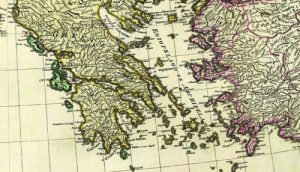
Photo: William Faden / wikipedia.org
The book of Acts tells us that, after preaching and teaching, Paul left Athens and traveled 50 miles [80.5 km] to Corinth. Situated near an isthmus that formed a land bridge between Greece and the Peloponnesus, Corinth thus controlled two harbors and commanded the trade between Asia and Rome. Therefore, it was not only the residence of thousands of Greeks and Roman citizens, but was a center of trade and tourism.
Populated at any given time by sailors and merchants, tradesmen and tourists, the city was a thriving hub of activity and home to every kind of evil imaginable. The ancient Greek word for immorality was in fact corinthiazesthia, literally meaning, “to live a Corinthian life.” The term “Corinthian girl” was a commonly used reference to a prostitute.
Licentiousness and immorality were the orders of the day, pagan temples dominated the landscape and prostitution was ranked as one of the highest paid professions of the area with historians reporting that literally thousands of “Corinthian girls” resided in pagan temples or roamed the streets of the city. It was here that Paul arrived in approximately AD 50, bursting with the good news of salvation. And it was here that he would repeatedly confront the evils of paganism that relentlessly plagued his new congregation.
It was also here that Paul would spend more time in actual residence than with any of the other churches in Asia, with the possible exception of Ephesus. Previously, he and his traveling companions visited major cities in various Asian provinces, preaching, teaching and gathering new converts together into congregations. Staying long enough to identify leadership and establish the foundations of each new church unit, the team would then move on. However, Corinth was a different story. Here Paul took up residence, sharing his life with the Corinthian believers for nearly two years while bringing the Gospel of Jesus to the city’s transient population as well.
Although there were literally hundreds of places of pagan worship in Corinth, from small shrines to huge, wealthy temple complexes, with a pantheon of equally as many gods, there were a few pagan deities whose cult practices had the strongest influence on the ancient Corinthians. And though the ritual practices themselves may be missing, many of the same attitudes toward immorality and a mistaken understanding of freedom exist today, not just in the world, but in the Church as well. A brief examination of five influential pagan cults sheds much light on the struggles of the early church in Corinth, the difficulties Paul faced in introducing a biblical worldview and righteous behavior to Corinthians still influenced by their pagan histories, and on difficult issues facing believers today.
Paul’s aching heart is revealed in 1 Corinthians 6:9–11. After his extended residence with the Corinthians, he has moved on to Ephesus and there, must address by letter some of the same issues he may have thought had previously been resolved. “Do you not know that the unrighteous will not inherit the kingdom of God?” his letter cries out, almost with a tone of disbelief that these Christians remained unaware of the spiritual consequences of continued immoral behavior. “Do not be deceived. Neither fornicators, nor idolaters, nor adulterers, nor homosexuals, nor sodomites…will inherit the kingdom of God. And such were some of you. But you were washed, but you were sanctified, but you were justified in the name of the Lord Jesus and by the Spirit of our God.”
1. Aphrodite, goddess of sexual freedom
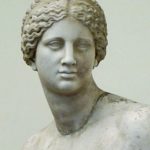
Photo: Marie-Lan Nguyen wikipedia.org
The temple to Aphrodite towered over the city, on the cliffs above the isthmus. She was known as the goddess of love, although the attitude and activities she stood for had nothing to do with love and everything to do with lust and licentiousness. She was also known as the protector of travelers, sailors and visiting tradesmen from all parts of the earth. At one time, historians say, her temple was occupied by thousands of temple prostitutes, although by the time of Paul’s arrival in the city, government-sponsored houses of prostitution supported by taxes levied on prostitutes had overshadowed the sexual activity within Aphrodite’s temple.
But it was Aphrodite’s stamp of approval on all things licentious that influenced the culture. Whether one visited a temple prostitute, a government house of pleasure, or one of the many brothels where child prostitutes could be purchased, there was no shame attached to sexual immorality. Homosexuality, sodomy and fornication were the norm. It was Paul’s message of sexual purity that set people apart, their belief in monogamy, heterosexuality and the sanctity of marriage putting them at odds with the overriding cultural norms. It was Paul’s heart cry that the Corinthian believers would truly understand their freedom in Christ, that being the freedom to choose righteousness and godly behavior rather than freedom to continue in sin.
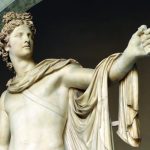
Photo: Livioandronico2013 wikipedia.org
2. Apollo: god of entertainment and youth
The temple of Apollo stood on a hill overlooking the city’s main forum and by the time Paul made his way to Corinth, it had lost some of its former luster. However, Apollo’s many followers remained loyal and his influence could be felt in every area of Corinthian life. Called the Bright One, he was understood to exemplify light, eternal youth, health and knowledge. He was also celebrated as the god of truth. Just as Aphrodite worship perpetuated sexual freedom, the worship of Apollo brought with it a personal search for enlightenment, each individual searching for his own truth, finding his own path, embracing his own spiritual reality. Truth was relative, and the younger, stronger and healthier you were, the more likely you were to maintain spiritual vigor as well.
In both of his letters to the Corinthians, Paul repeatedly encourages them regarding the Oneness of God, countering their belief in religious pluralism. Through his constant example while living with them, his countless references to the teachings of Torah and in his letters, Paul took an immovable stand for real truth, God’s truth, biblical truth. As a Jew, he would have recited the Shema (Deut. 6:4) often, proclaiming his conviction that there is but one God. In so doing, he was following the example and direction, not only of his forebears as revealed in the Torah, but also of his Jewish Messiah, Jesus.
3. Asklepios: the god of healing
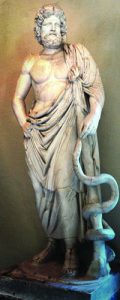
Photo: Michael F. Mehnert wikipedia.org
At the time of Paul, people from all over the known world traveled to the temple of Asklepios, located just outside of Corinth, to receive healing from this pagan god and his daughters: Hygieia, goddess of health, cleanliness and sanitation; Iaso, goddess of recuperation; Aceso, goddess of the healing process; Aglaea, goddess of beauty and magnificence; Panacea, goddess of universal remedy.
Petitioners arrived at the temple bearing clay replicas of the particular body part for which they were seeking healing. As part of a worship ritual, those body parts were hung around the temple, as prayers and alms were offered. Archaeologists have found hundreds of terracotta offerings to Asklepios in the form of hands, feet, breasts, limbs and other organs that were presented to this pagan god by pilgrims seeking a cure.
Some scholars have suggested that Paul alluded to these votives in 1 Corinthians 12 when he encouraged the Corinthians that individual parts are worthless without the rest of the body, reminding them that it was God alone who created the body with such synergy that the suffering of one part causes suffering to the whole. For those familiar with the temple of Asklepios, this would have been a powerful visual aid as Paul taught on the unity of the body of believers.
Although Asklepios worship perpetuated a belief that healing and health existed outside of the one true God, the cult of his daughters was equally damaging to the culture. Hygieia brought with her an utter obsession with cleanliness and diet, Aglaea associated physical beauty with health and perpetuated an obsession with appearance, and Panacea worshipers believed that this goddess held the key to a universal remedy that would heal all illness without requiring anything of the petitioner.
4. Cybele-Attis: the great mother
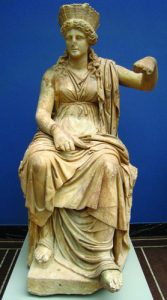
Photo: ChrisO wikipedia.org
This cult was based on Greek mythology that told the story of Cybele, the goddess mother who fell in love with a mortal shepherd named Attis. When Attis was unfaithful, Cybele used her power to drive him insane, and in a state of madness, Attis castrated himself and died. Overcome by mourning, Cybele restored Attis to life, an event that mythology says effected all of the natural world.
The practices of this cult were very extreme. Priests were stirred into a frenzy of excitement through music and dance, gashing their bodies with knives and broken glass, believing that such pain and disfigurement would cause them to achieve spiritual superiority and give them the power to control the lives of their followers. The music for these rituals was provided by new devotees who pounded on drums, gongs and cymbals. Although the practices of this cult did not affect the broader society as did some of the others, they were well known.
Paul’s reference to gongs and cymbals in 1 Corinthians 13 would have had a deep effect on his Corinthian hearers. Nothing is more important than love, Paul says. There is no power even in ecstatic experience or self-mutilation. His words may well have brought to the minds of some of his hearers bloody scenes of Cybele-Attis rituals that they had actually seen, or perhaps even participated in.
As Paul continued with his description of real love, the profound differences between this vicious and futile pagan cult and the heart of the true God of Israel would have been clearly illustrated. Brad Young further states: “Without love, the most powerful spiritual manifestations and experiences are entirely meaningless. Certainly the words of Paul are closely related to the words of Jesus, recorded in John’s gospel, ‘By this all men will know that you are my disciples, if you have love for one another.’ (John 13:35 RSV)”
5. Dionysus: the god of wine
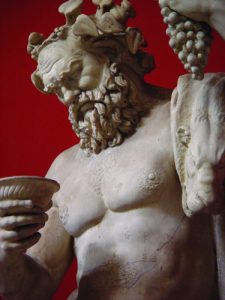
Photo: Marcus Aurelius at the German language wikipedia
The most popular of the Greek pantheon, Dionysian cultic worship could be described as one big party. Wine, sometimes containing other more powerful drugs, was used to help participants rid themselves of inhibitions and achieve ecstatic states of experience. Worshipers engaged in dancing, drinking, sexual promiscuity, varying degrees of undress and other forms of excessive behavior. It was only in a state of frenzy, they believed, that one could hold communion with god.
The Dionysian cult was not just prevalent in Corinth but was known in many places throughout the ancient world where its participants were notorious for drunkenness, raucous behavior and loud outbursts. Ancient documents detail their practices, with sacrificial rites occurring sometimes as often as five times a day. Sometimes including human sacrifice, the rituals were conducted to the accompaniment of shouting, banging on cymbals and female participants ululating.
There are many indications that pagan religions still exerted a powerful influence on the new believers in Corinth, creating confusion in their midst and sometimes division in the body. Converts were uncomfortable over meat that had been offered to idols; they had to be reminded not to attend sacrificial meals in pagan temples; there was drunkenness at their love feasts; sexual sin of the worst kind went unchecked in the congregation. Their worship services seemed to have been marked by the same raucous behavior and chaos that had prevailed during their pagan ritual practices. Paul had to encourage them by teaching that self-control and order should be the norm in their Christian worship services.
The influence that each one of these cults had on society went far beyond the actual participants and their specific rituals. Their pagan practices were not only socially acceptable but became normative behavior with no negative stigma attached. Consequently, the prevailing worldview was one of self-indulgence and godlessness with the same “I’m-okay-you’re-okay” philosophy that pervades much of Western society today.
As a Jewish rabbi from the pharisaic tradition, Paul was well aware that an understanding of, and commitment to, living a life pleasing to God was critically important not only for life in this world but for life in the world to come as well. If these Corinthians were going to become true disciples of Yeshua, they would need a massive paradigm shift in their thinking. They had accepted Yeshua, acknowledging Him as their Savior, believing that He had made the ultimate sacrifice for them on the cross. But that did not automatically erase their history or take away a destructive pagan worldview. They had no foundation for godliness. They were strangers to Torah.
According to Brad Young: “Paul believed every human being would experience either God’s abundant grace or divine wrath and the day of retribution. When dealing with the towering issues of his day, he affirmed the validity of Torah in his teachings and his practical theology. He quoted the Bible often and frequently discussed its application with the Corinthians. He talked about Torah constantly; this incessant occupation with the biblical foundation of his beliefs and his conceptual approach to his interactive theology might even be described as a passion. Paul was a Jewish theologian. He was a Pharisee, and he knew that the only answer for the true sanctification of the Corinthians was the wisdom and guidance found in Torah.”
However, Paul was also convinced these new Gentile believers could become true followers of Yeshua, and therefore followers of Torah, without becoming Jewish. Surely as Paul lived his life among them he would have shared his Jewish traditions; the love feasts he mentions in his letters may well be Shabbat celebrations. He would have familiarized the Corinthian believers with the cycle of holidays found in the book of Leviticus and the joy that comes with each celebration. But Paul would not have enforced Jewish tradition on these Gentile believers. Rather he was committed to helping them find the essence of Torah, a true biblical foundation, the heart and character of God.
He wanted the Corinthians to recognize that they were made in the image of that God and so it was, he taught them to make love their aim. He encouraged them to seek the gifts of God out of love and the desire to help those in need more efficiently. He wanted them to see love as the more excellent way. Love was to characterize the ministry of every individual Christian as well as the whole Christian community; love was to be the basis of ministry in the local congregation.
Paul believed as the Corinthians saw the incredibly powerful, all faithful, all loving God of Israel juxtaposed with the vile, vicious godless pagan deities they had once served, their lives would change. They would recognize the value of human life, the sanctity of marriage, the importance of sexual purity, sobriety…their pagan worldview would be replaced as their minds were renewed. The Word of God was the answer.
Fortunately, pagan religions and practices that were prevalent in Corinth are very rarely found in our Western world and are certainly absent from our churches. But some of the same attitudes and issues that plagued those early Corinthian believers have infiltrated our churches today. Sexual impurity, homosexuality, a low regard for Scripture, an obsession with physical appearance and even abortion, eating disorders, divorce and drug abuse now plague our Christian congregations.

Photo: IngridHS shutterstock.com
Paul’s heart cry to the Corinthians is as valid for us as it was for those ancient believers. Our God is the God of love, mercy, patience and compassion. But He is also a God who requires a righteous standard of behavior from His followers. Paul asked the Corinthians to recognize that there were serious consequences to be paid by those who continued to indulge in immoral behavior. He cried out to them, pleading for their understanding that freedom in Christ does not mean freedom to do whatever we want. Freedom in Christ means the freedom to choose to be bondservants to the Most High God. The Corinthian church needed a worldview adjustment; perhaps the church today does as well. Paul repeatedly told the Corinthians their answers would be found in the Word of God. I can’t help but think if he wrote us a letter today, he would tell us the same thing.
Hoerth, Alfred J. Archaeology and the Old Testament. Grand Rapids, Michigan: Baker Academic, 2009.
https://sites.google.com/site/ancientgreececorinth/home/daily-life-in-c
https://en.wikipedia.org/wiki/Ancient_Corinth
Packer, James I., Merrill C. Tenney and William White, Jr., eds. Nelson’s Illustrated Encyclopedia of Biblical Facts. Nashville, Tennessee: Thomas Nelson Publishers, 1995.
Segal, Alan F. Paul the Convert: the Apostolate and Apostasy of Saul the Pharisee. Binghamton, New York: Yale University Press, 1990.
www.padfield.com/2005/corinth.html
Young, Brad. Paul, the Jewish Theologian: a Pharisee among Christians, Jews, and Gentiles. Peabody, Massachusetts: Hendrickson Publishers, Inc, 1997.
All logos and trademarks in this site are property of their respective owner. All other materials are property of Bridges for Peace. Copyright © 2025.
Website Site Design by J-Town Internet Services Ltd. - Based in Jerusalem and Serving the World.